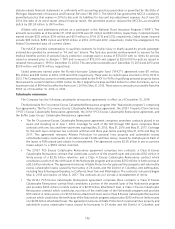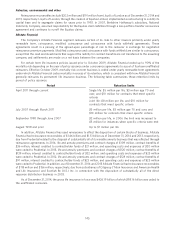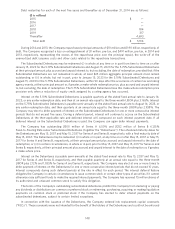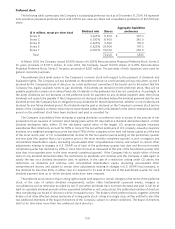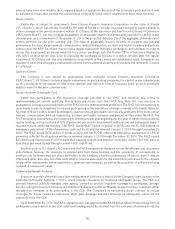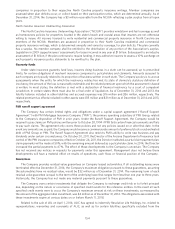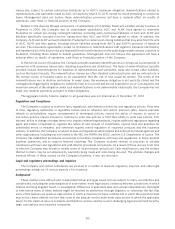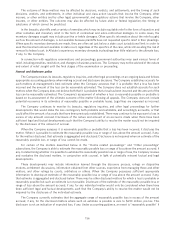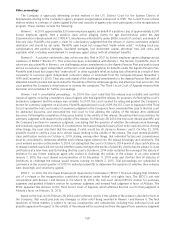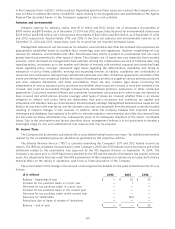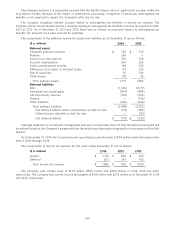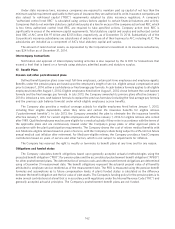Allstate 2014 Annual Report Download - page 253
Download and view the complete annual report
Please find page 253 of the 2014 Allstate annual report below. You can navigate through the pages in the report by either clicking on the pages listed below, or by using the keyword search tool below to find specific information within the annual report.CEA may issue, an existing $3.56 billion reinsurance layer, and finally, if needed, assessments on participating insurance
companies. Participating insurers are required to pay an assessment, currently estimated not to exceed $1.66 billion, if
the capital of the CEA falls below $350 million. Participating insurers are required to pay a second additional
assessment, currently estimated not to exceed $312 million, if aggregate CEA earthquake losses exceed $10.52 billion
and the capital of the CEA falls below $350 million. Within the limits previously described, the assessment could be
intended to restore the CEA’s capital to a level of $350 million. There is no provision that allows insurers to recover
assessments through a premium surcharge or other mechanism. The CEA’s projected aggregate claim paying capacity is
$10.52 billion as of September 30, 2014 and if an event were to result in claims greater than its capacity, affected
policyholders may be paid a prorated portion of their covered losses, paid on an installment basis, or no payments may
be made if the claim paying capacity of the CEA is insufficient.
All future assessments on participating CEA insurers are based on their CEA insurance market share as of
December 31 of the preceding year. As of December 31, 2013, the Company’s market share of the CEA was 13.9%. The
Company does not expect its CEA market share to materially change. At this level, the Company’s maximum possible
CEA assessment would be $273 million during 2015. These amounts are re-evaluated by the board of directors of the
CEA on an annual basis. Accordingly, assessments from the CEA for a particular quarter or annual period may be
material to the results of operations and cash flows, but not the financial position of the Company. Management
believes the Company’s exposure to earthquake losses in California has been significantly reduced as a result of its
participation in the CEA.
Texas Windstorm Insurance Association
The Company participates as a member of the Texas Windstorm Insurance Association (‘‘TWIA’’) which provides
wind and hail coverage to coastal risks unable to procure coverage in the voluntary market. Wind and hail coverage is
written on a TWIA-issued policy. Under current law, as amended in 2009, to the extent losses exceed premiums and
reinsurance, TWIA follows a funding structure first utilizing funds set aside from periods (including prior years) in which
premiums exceeded losses. Once those funds and available reinsurance are utilized, TWIA will issue up to $1 billion of
securities, 30% of which will be repaid by participating insurers assessments and 70% of which will be repaid by
surcharges on coastal property policies. After those funds are depleted, TWIA can issue $500 million of securities
which will be repaid by participating insurer assessments. Participating companies’ maximum assessment is capped at
$800 million annually. The Company’s current participation ratio is approximately 13% based upon its proportion of the
premiums written. The TWIA board has not indicated the likelihood of any possible future assessments to insurers at
this time. However, assessments from TWIA for a particular quarter or annual period may be material to the results of
operations and cash flows, but not the financial position of the Company.
New Jersey Unsatisfied Claim and Judgment Fund
The NJUCJF provides compensation to qualified claimants for bodily injury or death caused by private passenger
automobiles operated by uninsured or ‘‘hit and run’’ drivers. The fund also provides reimbursement to insurers for the
medical benefits portion of personal injury protection coverage paid in excess of $75,000 with no limits for policies
issued or renewed prior to January 1, 1991 and in excess of $75,000 and capped at $250,000 for policies issued or
renewed from January 1, 1991 to December 31, 2004. NJUCJF expenses are assessed on companies writing motor
vehicle liability insurance in New Jersey annually based on their private passenger and commercial automobile written
premiums. The NJUCJF was merged into the New Jersey Property Liability Guaranty Association who collects the
assessments. Assessments to the Company totaled $9 million in 2014.
North Carolina Reinsurance Facility
The North Carolina Reinsurance Facility (‘‘NCRF’’) provides automobile liability insurance to drivers that insurers are
not otherwise willing to insure. All insurers licensed to write automobile insurance in North Carolina are members of the
NCRF. The Company also collects NCRF surcharges on all automobile policies written in the state. Premium, losses and
expenses ceded to the NCRF and surcharges are remitted to the state. The NCRF results are shared by the member
companies in proportion to their respective North Carolina automobile liability writings. Member companies are
assessed or collect based on their participation ratios which are determined annually. As of September 30, 2014, the
NCRF reported a surplus of $15 million in members’ equity to cover future losses.
North Carolina Joint Underwriters Association
The North Carolina Joint Underwriters Association (‘‘NCJUA’’) was created to provide property insurance for
properties that insurers are not otherwise willing to insure. All insurers licensed to write property insurance in North
Carolina are members of the NCJUA. Premiums, losses and expenses of the NCJUA are shared by the member
153


